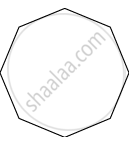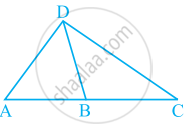Advertisements
Advertisements
प्रश्न
The diagonals of a rhombus are 6 .cm and 8 cm. State the angle at which these diagonals intersect.
उत्तर
The diagonals of a Rhombus always intersect at 90°.
APPEARS IN
संबंधित प्रश्न
ABCD is a parallelogram, AD is produced to E so that DE = DC and EC produced meets AB produced in F. Prove that BF = BC.
In a quadrilateral, define of the following Sides.
In a quadrilateral, define of the following Opposite sides .
Complete of the following, so as to make a true statement:
The measure of each angle of a convex quadrilateral is ..... 180°.
Complete of the following, so as to make a true statement:
In a quadrilateral the point of intersection of the diagonals lies in .... of the quadrilateral.
In Fig. 16.19, ABCD is a quadrilateral.
How many pairs of opposite sides are there?

A quadrilateral has three acute angles each measures 80°. What is the measure of the fourth angle?
The sides of a quadrilateral are produced in order. What is the sum of the four exterior angles?
PQRSTU is a regular hexagon. Determine each angle of ΔPQT.
In the given figure, ABCD is a trapezium. Find the values of x and y.

Complete the following statement by means of one of those given in brackets against each:
f consecutive sides of a parallelogram are equal, then it is necessarily a ..................
Which of the following quadrilateral is not a rhombus?
Use the following figure to find the value of x

The angles A, B, C and D of a trapezium ABCD are in the ratio 3: 4: 5: 6. Le. ∠A : ∠B : ∠C : ∠D = 3:4: 5 : 6. Find all the angles of the trapezium. Also, name the two sides of this trapezium which are parallel to each other. Give reason for your answer.
Observe the figure below and find out their name.

The angles of a quadrilateral are in the ratio 2 : 4 : 5 : 7. Find all the angles
What is the maximum number of obtuse angles that a quadrilateral can have?
In given figure, name any four angles that appear to be acute angles.
Using the information given, name the right angles in part of figure:
AE ⊥ CE
What conclusion can be drawn from part of given figure, if DB is the bisector of ∠ADC?
